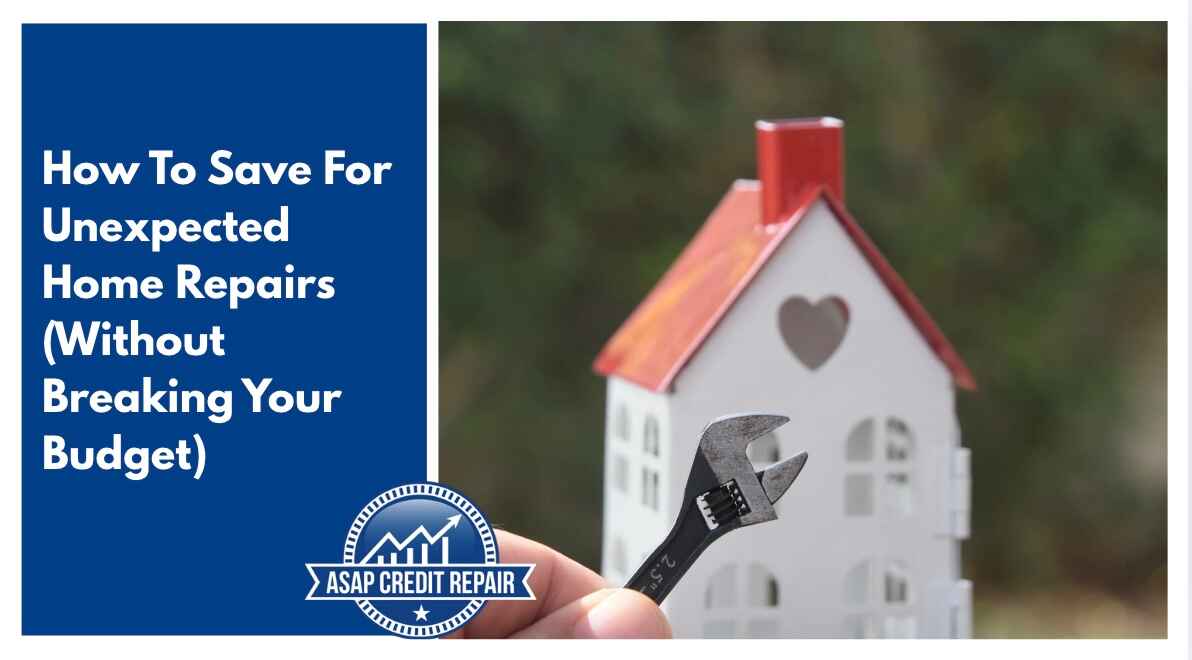How homeowners are starting to approach financial planning has changed dramatically. Soon it will be unrecognizable from the reactive budgeting we've grown comfortable with.
With inflation impacting everything from materials to labor costs, unexpected home repairs now average $3,000-$15,000 per incident. The rise of DIY culture alongside professional contractor shortages has created a different homeownership experience entirely.
Over the past 17 years running my finance and credit repair company, I've helped thousands of homeowners navigate these challenges. The same questions keep coming up: "How much should I save?" and "Is it even worth it with these crazy costs?"
I recently spoke at a homeowners financial planning workshop, and one data point stood out that answers these questions perfectly:
Does Emergency Home Repair Funds Matter More Than Ever?
Quick Answer: Yes, but your approach needs to change.
Home repair savings is one of the few financial strategies that compounds over time. Unlike credit cards that max out when you need them most, a solid emergency fund keeps working long after you've established it.
Here's what I've learned after helping thousands+ of clients manage home repair crises:
The Compounding Effect of Consistent Savings
Every monthly contribution builds your financial foundation. Every bonus deposit strengthens your safety net. Every tax refund addition creates more security.
That’s the power of compounding: it’s not about one big moment, it’s about quiet, steady progress over time.
The real difference between homeowners who feel confident and those stuck living paycheck to paycheck? It’s consistency. Even small amounts saved consistently can grow into a buffer that protects you from unexpected home repair bills.
But here’s the challenge, home repair emergencies aren’t disappearing; they’re evolving. Today’s homes rely on smarter technology, more complex systems, and rising labor costs. What used to be a $200 fix a decade ago could now set you back $1,000 or more.
That’s why modern homeowners need modern savings habits. It's not just about putting money aside.
It's about staying ahead of change.
What's Changed: Why Traditional Advice Falls Short
The old advice, “save a little each month and you’ll be fine”, doesn’t hold up anymore.
With repair costs rising faster than inflation and homes becoming more tech-driven, yesterday’s strategies can leave today’s homeowners exposed. It’s time to rethink how we prepare for unexpected expenses.
The New Reality of Home Repair Costs
I've watched repair estimates change dramatically over my career. What used to cost $500 now runs $1,500. What was a $2,000 fix is now $6,000.
Here's the breakdown from my client data:
- HVAC repairs: Up 65% since 2019
- Plumbing emergencies: Up 45% since 2019
- Electrical work: Up 70% since 2019
- Roofing repairs: Up 80% since 2019
Here’s the chart showing how home repair costs have changed from before 2019 to 2025:
HVAC Repairs: $500 → $825
Plumbing Emergencies: $1,000 → $1,450
Electrical Work: $800 → $1,360
Roofing Repairs: $1,500 → $2,700
This visual makes it clear, repair costs are climbing fast, and traditional savings advice isn’t keeping up.
Why Some Homeowners Are Giving Up on Emergency Funds
There's rising anxiety among homeowners I work with. They see these numbers and feel like savings can't keep up.
Some even question whether setting aside money for home repairs is worth the effort anymore.
But here’s why they’re wrong:
The cost landscape has changed, but the need hasn’t disappeared.
Material shortages, labor costs, and supply chain issues are making traditional repair estimates a thing of the past.
And, a more important topic? Your Credit Score
Right now, your credit score matters more than ever.
In a market where even a 0.5% change in interest rate can cost you thousands over the life of a loan, the difference between a good and great credit score can mean:
- Lower financing rates on emergency repairs
- Better approval odds for home improvement loans
- More flexible payment options when the unexpected happens
When your savings can’t cover it all, your credit becomes your safety net. Don’t let it fall behind.
Common Mistakes That Cost Homeowners Thousands
Mistake #1: Using Wrong Measurement Standards
Many homeowners measure their emergency fund success by old standards. They assume that if repairs cost more, savings are less effective.
The truth: Financial security itself has value. Your fund doesn't need to cover every possible expense. It needs to prevent debt and give you options.
Mistake #2: Avoiding Savings When You Need It Most
The worst time to stop building your emergency fund is when costs are rising. Yet that's exactly what many homeowners do.
From my experience: Homeowners who maintain consistent savings weather repair storms better. They avoid high-interest debt and have negotiating power with contractors.
How Much Should You Actually Save?
The New Home Emergency Fund Formula
Forget the old "3-6 months expenses" rule for home repairs.
Here's what actually works in 2025:
- For homes under 10 years old: $2,000-$5,000 minimum
- For homes 10-20 years old: $5,000-$10,000 minimum
- For homes over 20 years old: $10,000-$20,000 minimum
Why These Numbers Make Sense
I've analyzed thousands of repair bills. These ranges cover 85% of single emergency repairs without forcing homeowners into debt.
Real client example: Sarah's 15-year-old home needed a new HVAC system. Total cost: $8,500. Her $9,000 emergency fund covered it completely. No debt, no stress, no credit damage.
Strategic Savings: What Actually Works
The 1% Rule (Updated for 2025)
Save 1% of your home's value annually for repairs and maintenance. But split it strategically:
- 60% for emergencies (unexpected breakdowns)
- 25% for preventive maintenance (avoiding bigger problems)
- 15% for upgrades (energy efficiency, value-adds)
Smart Saving Strategies I Recommend
- High-yield savings accounts earn 4-5% while keeping funds accessible. I recommend keeping your emergency fund separate from other savings.
- Automatic transfers remove the decision-making. Set up weekly transfers of $50-$100 depending on your target amount.
- Seasonal boosters help you save faster. Use tax refunds, bonuses, or seasonal work income to boost your fund.
The Psychology of Home Repair Savings
Why Mental Preparation Matters
After 17 years in finance, I've learned that financial preparation is half psychological. Homeowners with emergency funds handle repairs differently.
They negotiate better rates. They get multiple quotes. They avoid panic decisions that cost thousands extra.
Building Confidence Through Preparation
Prepared homeowners have options. They can choose quality contractors instead of whoever's available immediately. They can address problems before they become disasters.
Unprepared homeowners have stress. They accept the first quote. They use credit cards at high interest rates. They defer maintenance until small problems become major expenses.
Modern Home Repair Challenges
Smart Home Integration Costs
Modern homes include technology that older emergency fund advice didn't consider. Smart thermostats, security systems, and automated features require specialized repair knowledge.
Average smart home repair costs I've seen: $400-$2,500 per incident.
Energy Efficiency Requirements
New building codes and efficiency standards affect repair costs. Simple replacements often require system upgrades.
Example from my files: Replacing a basic water heater now often requires electrical upgrades, permits, and code compliance work. Total cost difference: $1,200-$3,500 more than the old "simple replacement."
When Emergency Funds Aren't Enough
The Credit Repair Connection
Sometimes, even homeowners with solid emergency savings face repair costs that blow past what they’ve set aside. A sudden HVAC failure in the middle of summer or a major roof leak after a storm can quickly rack up thousands in unplanned expenses.
This is where your credit health becomes a powerful backup tool, not just a number on a report.
What I often tell my clients is this: good credit opens doors when savings fall short. One of the most valuable tools is a home equity line of credit (HELOC). Unlike high-interest credit cards, HELOCs often come with much lower interest rates, flexible repayment terms, and access to a larger pool of funds, all based on the equity you’ve built in your home.
If your credit score is solid, you’re more likely to qualify for a HELOC or personal loan with favorable terms. This means you can spread out repair costs over time without being buried in high-interest debt.
Below is a visual comparison showing how your credit score impacts both the interest rate and approval chance for emergency funding options like personal loans or HELOCs. It highlights just how costly poor credit can be when unexpected home repairs strike.
On the other hand, if your credit is damaged, those same backup options may not be available, or they’ll come at a much higher cost. You may be forced to rely on credit cards with steep interest rates, payday loans, or defer necessary repairs altogether.
This is why I emphasize to clients: repairing your credit isn’t just about buying power, it’s about having options when emergencies hit.
In today’s world, a strong credit profile is part of your emergency plan.
Building Multiple Safety Nets
Smart homeowners don't rely on savings alone:
- Primary emergency fund (liquid savings)
- Secondary credit options (HELOC, personal loans)
- Insurance coverage (homeowner's, warranties)
- Professional network (trusted contractors with fair pricing)
The ROI of Home Repair Savings
Financial Returns Beyond Repair Coverage
Emergency funds provide returns beyond covering repair costs:
- Avoiding high-interest debt saves 18-29% annually (average credit card rates)
- Negotiating power can reduce repair costs by 10-20%
- Preventive maintenance extends equipment life by 5-10 years
- Property value protection maintains home equity
Real Numbers from My Client Base
Clients with adequate emergency funds save an average of $2,400 annually compared to those using credit for repairs. This includes:
- Lower interest costs
- Better contractor rates
- Avoided emergency service fees
- Prevented major system failures
Actionable Steps to Start Today
Week 1: Assessment and Goal Setting
- Calculate your target amount using the age-based formula above
- Audit current savings to see where you stand
- Set a realistic timeline (typically 12-24 months to fully fund)
Week 2: Automate Your System
- Open a dedicated high-yield savings account
- Set up automatic weekly transfers
- Schedule quarterly reviews to track progress
Week 3: Build Your Network
- Research and vet 2-3 contractors in each major category
- Understand your home's systems and typical lifespans
- Review insurance coverage for what's covered vs. what isn't
The Bottom Line: Why This Still Matters
If you're asking whether home repair savings still works, the answer is absolutely yes. But not in the old way.
It's not just an emergency fund anymore. It's your financial security layer for routine maintenance, unexpected failures, and modern home challenges.
Home repair savings has become a lever for peace of mind and financial stability. It's a strategic asset, not just a safety net.
The real question: Can you afford not to save?
Credit card debt compounds the moment you use it for repairs. Emergency savings builds on itself. It's one of the few financial strategies that gives you more security tomorrow for what you save today.
As home costs continue rising, emergency savings stays relevant because it supports every layer of homeowner financial security. It creates a foundation you own, not debt you owe.
The homeowners who thrive are the ones who stay prepared. They keep saving consistently, even when costs shift unexpectedly.
Savings isn't just about covering repairs. It's about financial freedom. It's about being ready when your home needs attention, wherever that attention is required.
In an unpredictable cost landscape, home repair savings gives you something stable. A long-term strategy that doesn't vanish when your income fluctuates.
For homeowners planning beyond next month, it's still one of the smartest investments you can make.

